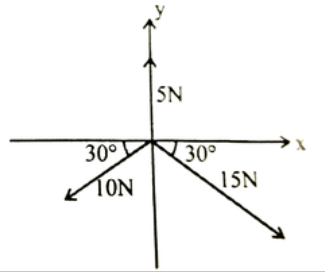Find the value of the unknow force if the given set of force shown in figure are in equilibrium.


∑Fx=0
:. F−3cos60∘−10sin60∘=0
F=10.16N
∑Fy=0
:. R+3sin60∘−10cos60∘=0
R=2.4N
Topper's Solved these Questions
- LAWS OF MOTIONBOOK - DC PANDEY ENGLISHCHAPTER - LAWS OF MOTIONEXERCISE - Objective Question
32 Videos
- LAWS OF MOTIONBOOK - DC PANDEY ENGLISHCHAPTER - LAWS OF MOTIONEXERCISE - Comprehension
9 Videos
- LAWS OF MOTIONBOOK - DC PANDEY ENGLISHCHAPTER - LAWS OF MOTIONEXERCISE - Assertion And Reason
28 Videos
- KINEMATICS 1BOOK - DC PANDEY ENGLISHCHAPTER - KINEMATICS 1EXERCISE - INTEGER_TYPE
15 Videos
- LAWS OF THERMODYNAMICSBOOK - DC PANDEY ENGLISHCHAPTER - LAWS OF THERMODYNAMICSEXERCISE - Level 2 Subjective
18 Videos
Similar Questions
Find the magnitudes of the unknown forces if the sum of all forces is zero (figure)

View SolutionWhich of the following sets of concurrent force may be in equilibrium?
View SolutionWhich of the following sets of concurrent force may be in equilibrium?
View SolutionWhich of the following sets of concurrent force may be in equilibrium?
View SolutionSome electric lines of force are shown in figure. For points a and B

View SolutionFind the force of friction acting between both the blocks shown in the figure.
View SolutionFind the magnitude of the resultant of shown forces :-

View SolutionWhat is the maximum value of the force F such that the block shown in the figure does not move?

View SolutionA block is placed on a rough horizontal plane. Three horizontalforces are applied on the block as shown in the figure. If the block is in equilibrium, find the friction force acting on the block.

View SolutionThe force acting on a body moving along x-axis variation of the particle particle shown in the figure. The body is in stable equilibrium at
 .
.
View Solution
